Day 30 – Seal Gaps Around Pipes
Do you have an open door policy for drafts and bugs?
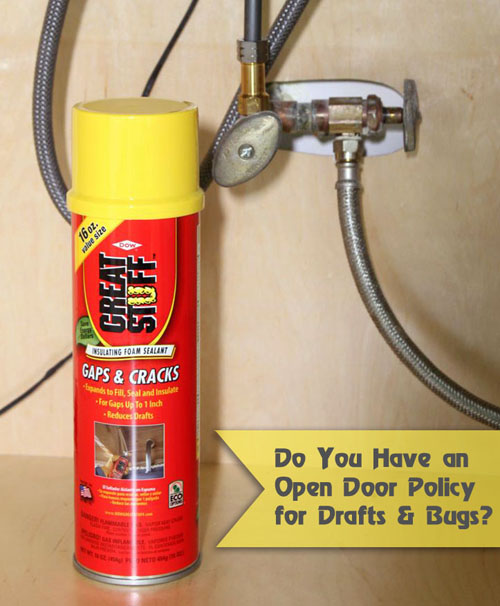
Of course not! Wait… you might and not know it. Have you looked under your sinks around the water pipes? If you have gaps around the pipes, you have the welcome sign up for cold air and bugs. Take a few minutes to seal around pipes with GREAT STUFF and you’ll stop them from entering your home.
Before GREAT STUFF approached me about writing a sponsored post for them, I was already a huge fan of their product. And between you and me, this post was already on the list of 31 Days of Handy Home Fixes! But, let’s keep that secret, because we don’t need GREAT STUFF to get an inflated ego. Ha, ha. Get it? Inflated. Oh yes, GREAT STUFF expands!
So much so, that I created a second head when I was working on my kitchen renovation. (I think my Halloween costume is complete, right?!)
But seriously, this is GREAT STUFF! It will fill in any gaps and holes in your home and foundation to prevent bugs and drafts from coming in. GREAT STUFF is easy to use, simply shake the can for 30 seconds. Add the spray nozzle. Don’t forget to put on gloves and eye protection. I created a super quick video to show you how to use GREAT STUFF.:
Spray GREAT STUFF into the gaps around your pipes. Do not overfill as GREAT STUFF expands as it cures.
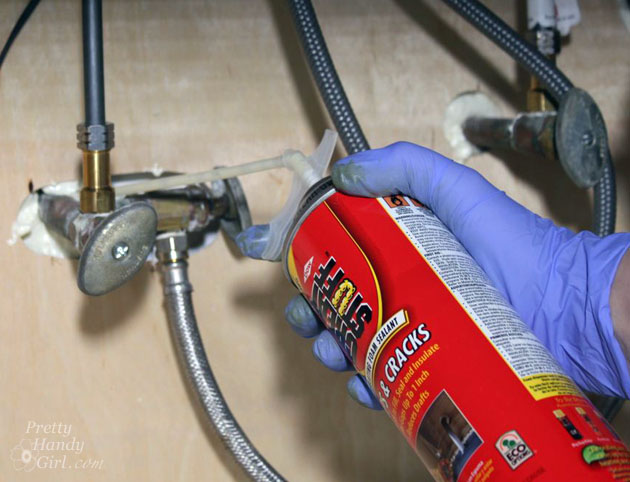
Keep a wet wipe or paper towel nearby to wipe off the nozzle and wipe up any drips.
Once the GREAT STUFF has cured, trim off any excess with a serrated blade if necessary.
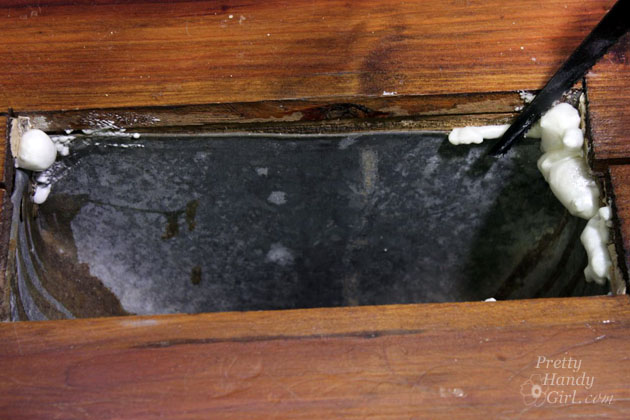
Here are just a few places you can use GREAT STUFF:
Around plumbing pipes under your sink:
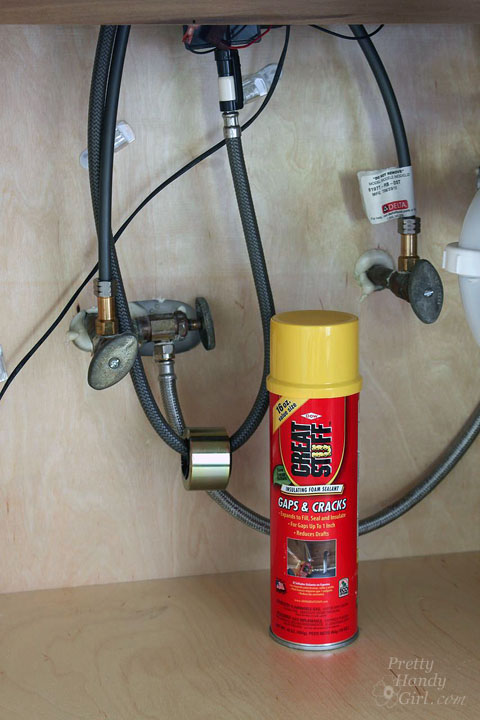
In the openings and gaps in your floor vents:
Around pipes and wires entering your home’s foundation:
Have you checked under your sinks or around your foundation lately? Buy a can of GREAT STUFF and seal all the gaps. Then enjoy your winter draft-free and your summers bug-free ;-).
Check out the Dow GREAT STUFF Pinterest board for more ways to use GREAT STUFF.
Pin for later!
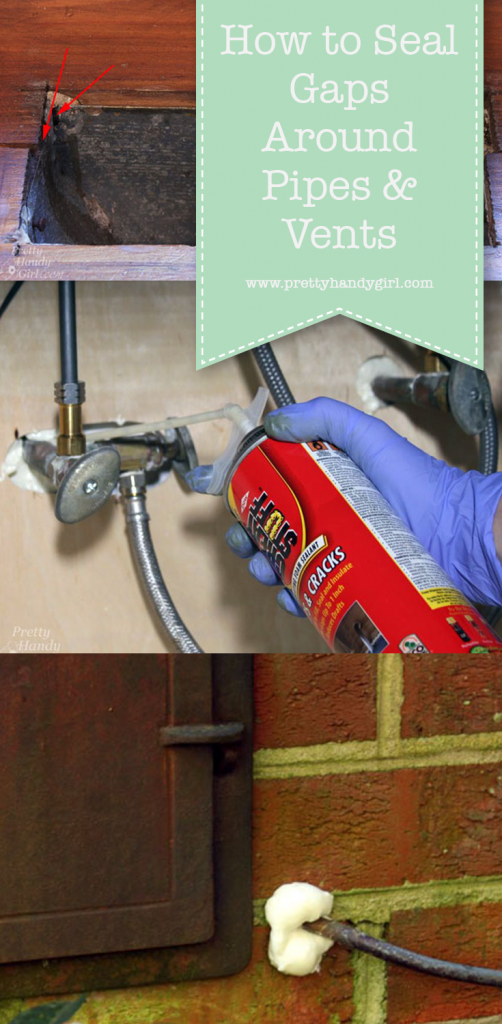
Disclosure: This post was sponsored by GREAT STUFF. I was compensated for my time. As always, I’m extremely picky about the products I promote. If I don’t like a product, you won’t see it mentioned. All projects and opinions are my own. I was not told what to write or say about GREAT STUFF.
Other tips in the 31 Days of Handy Home Fixes series:


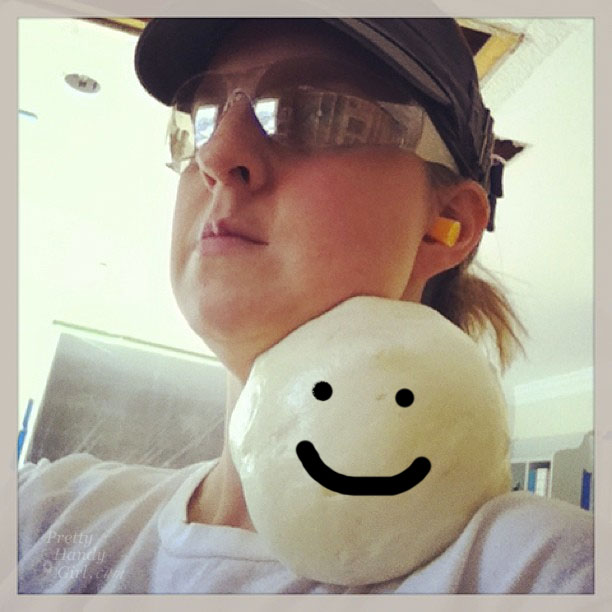
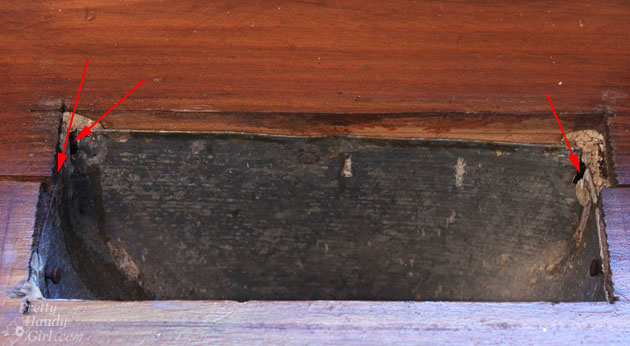

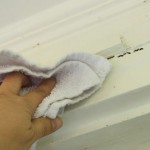

I see this post is a few years old, but I’ve effectively “mouse-proofed” many houses and Great Stuff isn’t really so great for filling in gaps around pipes, etc. , at least as far as preventing rodents from getting in a bldg. It might work for a while, but rodents happily eat through Great Stuff or any kind of foam (or fiberglass)- they even love to make nests with it (I see Great Stuff makes a specific “pest-proof” version, but the reviews beg to differ.). 1/4″ hardware cloth covered with wood filler or epoxy (or nothing if it is not exposed to the outside and aesthetics aren’t an issue)- or solid sheet metal cut and fitted and attached to the wall around the gap (all edges caulked)- works great. Even easier- and more attractive- is to buy metal escutcheons made for exactly this purpose- found in any hardware store- they just need to be attached firmly with screws and or some kind of strong adhesive or caulk, filling in around all edges with caulk. Solid wood cut to shape (cut a hole in a circle or square of regular 1x lumber with a hole saw exactly the size of the pipe- then cut it in half and attach each side around the pipe) also works- rodents can chew though wood also, but it takes them quite a while and if so, you can hear them in time to make a metal patch before they can get in. (and if you caulk carefully to prevent any air infiltration, they are unlikely to be attracted to that spot). GS is fine for insulation and drafts and possibly bugs if you are meticulous with it- but a solid sheet of metal or wood is the way to keep mice and other rodents out completely- for good.
Thanks Lauren, I just ran into the Great Stuff pest control the other day.
Hi Brittany – I’m getting started a little late in life to become a DIY’er (55 yrs) but have always wanted to be a “handy girl” myself. Now that I’m single and a homeowner (and currently unemployed) I’m having to learn to do a LOT on my own! It’s rewarding but often difficult to find help online for my specific situation. I found your awesome website & will be looking for more guidance in the future I’m sure! Right now I’m in the middle of replacing a copper water supply line from underneath the kitchen sink to where the dishwasher goes. The current copper line goes down to the crawl space underneath the house and comes up in a very inconvenient location of the floor under the dishwasher. It’s 40 yrs old and tiny & I don’t like the configuration at all. I’m going to be replacing the copper piping with PEX hose through the kitchen cabinetry. I drilled 1-½” holes already. I discovered mouse droppings and I already have lots of bug problems (out here in the rural Colorado country surrounded by orchards & livestock) so now I’m trying to decide how to fill the gaps around the hose as it goes through each hole. There are also some voids in-between cabinets as well as no flat surface backing when filling the holes like in your video. So what would you suggest? Because if I spray the Great Stuff it will just ooze through the hole & down to the floor. Also, have you worked with Pex hose and do you know if its “mouse-bite-resistant”? Thanks! 🙂
Gutta percha works outdoors and is a nice gray color line cement grout, but it needs to be replaced periodically. I have used acrylic caulk indoors when the spaces are small. This is NOT painters caulk. It cannot be painted.
Hopefully you don’t have PEX pipes. Spray foam is not supposed to come in contact with PEX. The PEX manufacturer should have an approved list of sealants that can be used in contact with their pipes.
John, I had no idea!!! Thank you for commenting.
OH!!! I just wrote a question down below and I’ll be using PEX hose!! NOW I see THIS WARNING! Maybe I can find a different type of compression hosing? I need to run 12 ft of hose and the longest braided-poly-compression hose I can find for dishwashers is 10ft. Do you think it would be safe to put a coupling in-between two 6 ft hoses?
Yes! Great Stuff is truly great. At your suggestion I picked up a can to seal around the window air conditioning unit shell. Old Man Winter throws a fit here and I don’t want a crazy breeze coming through when it is -13 outside. Thanks!!
Christina, oh that’s a great use for GREAT STUFF!
Thanks so much or introducing me to Great stuff – this is what I have been looking for – I need to get my hands on this stuff!!!
Shashi, hooray! Glad I could introduce you ;-).